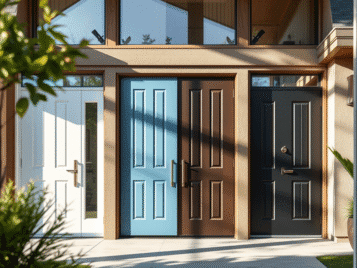Wood–plastic composite (WPC) doors from SamratHPL already solve humidity, warp, and termite issues, but they bring one more perk: a dense, uniform core that accepts modern smart‑lock hardware without the splitting risk you face in softer woods. That said, WPC’s high density needs different drill bits, pilot holes, and torque settings than pine or teak. Get those details wrong and you’ll strip threads or crush the lock chassis; get them right and you gain keyless entry, audit trails, and tighter security in under two hours.
Below is a practical, brand‑agnostic guide tailored for WPC frames and slabs in homes from Singapore condos to Stockholm townhouses—no guesswork, no gimmicks.
1. Choose the Right Lock Platform
| Lock style | Best for | Hole pattern | Door thickness sweet spot |
|---|---|---|---|
| Mortise (Euro or ANSI) | High‑security main doors | 54 mm cross‑bore + 25 mm latch | 38–55 mm |
| Deadbolt retrofit | Upgrading existing bore | 54 mm cross‑bore | 35–50 mm |
| Rim / surface‑mount | Glass‑insert doors | Minimal drilling | 35 mm+ |
Tip: SamratHPL colour‑through and laminated WPC slabs come standard at 40 mm or 45 mm thick, matching most smart‑lock backsets. Always verify before ordering the lock.
2. Tools & Materials Checklist
- Carbide‑tipped hole saw (54 mm / 2‑1⁄8″)
- 25 mm spade or auger bit for latch bore
- 3 mm and 5 mm HSS pilot bits
- Countersink bit (90 °)
- Torque‑limiting cordless driver (max 8 N·m)
- #2 Philips or Torx bits (per lock spec)
- Neutral‑cure silicone (colour‑matched)
- Isopropyl alcohol wipes
- Painter’s tape, ruler, and pencil
3. Six‑Step Installation Walk‑Through
Step 1 – Mark the Backset
Most smart locks specify 60 mm or 70 mm from door edge to centre‑bore. Use the manufacturer’s template, level it, and tape it firmly.
Step 2 – Drill the Cross‑Bore
Fit a carbide hole saw and drill halfway from each side to avoid breakout. WPC dust is fine—wear a mask.
Step 3 – Drill the Latch Bore
Switch to a 25 mm spade bit; drill square to the edge until it meets the cross‑bore. Vacuum dust for a snug latch fit.
Step 4 – Pre‑Drill Pilot Holes
WPC’s 750 kg/m³ density holds screws well but can split if you skip pilots.
- Use 3 mm pilot for #8 wood screws.
- Depth: 90 % of screw length.
Step 5 – Assemble & Torque
Mount the exterior keypad, route the cable, insert the latch, then attach the interior escutcheon. Set your driver to 6–7 N·m; overtightening compresses the composite and misaligns the deadbolt.
Step 6 – Seal & Test
Run a thin silicone bead around the exterior flange—keeps out monsoon rain or Scandinavian snow. Program a code, cycle the bolt 10 times, and confirm no drag.
4. Common Pitfalls—And Fixes
| Issue | Cause | Cure |
|---|---|---|
| Deadbolt binds | Bore holes off‑centre by >1 mm | Widen strike plate slot by 2 mm |
| Screw threads strip | No pilot or wrong bit | Fill hole with two‑part epoxy, re‑drill pilot |
| Keypad flexes | Over‑torqued screws crush WPC | Back off ½ turn, add nylon washer |
5. Global Cost Snapshot (mid‑2025)
| Region | Wi‑Fi mortise kit* | Installation time | Typical labour cost** |
|---|---|---|---|
| India | ₹13 000–₹18 000 | 1.5–2 h | ₹1 200–₹1 800 |
| Germany | €210–€260 | 1–1.5 h | €80–€110 |
| USA | $220–$290 | 1–1.5 h | $90–$140 |
*Includes lock, latch, strike, and batteries.
**Assumes certified locksmith; DIY saves labour, not warranty.
6. Battery & Connectivity Tips
- Battery life: Dense WPC insulates; expect 9–12 months on four AA lithiums.
- Signal strength: WPC contains no metal, so Wi‑Fi/BLE antennas face no attenuation.
- Power backup: Choose models with USB‑C emergency jump or physical key override.
7. Maintenance Plan
- Quarterly: Wipe keypad, check screw torque (hand‑tight).
- Bi‑annual: Replace batteries; log into app to update firmware.
- Annual: Dab silicone grease on latch bolt for smooth travel.
8. Quick‑Decision Matrix
| Priority | Suggested path |
|---|---|
| Highest burglary resistance | Euro mortise smart lock + SamratHPL WPC 45 mm slab |
| Fast retrofit of existing bore | Deadbolt smart lock |
| Minimal drilling on glazed doors | Rim‑mount model |
| Lowest long‑term upkeep | Any smart lock on colour‑through WPC |
Final Word
Installing a smart lock on a SamratHPL WPC door is less about brute force and more about precision—pilot holes, correct torque, siliconed seals. Get those right and you unlock a new chapter in home convenience: no jingling keys, remote guest access, and a door core that shrugs off tropical humidity or alpine frost. Your smart device—and your WPC door—should both work quietly in the background, so you can focus on life beyond the threshold.



